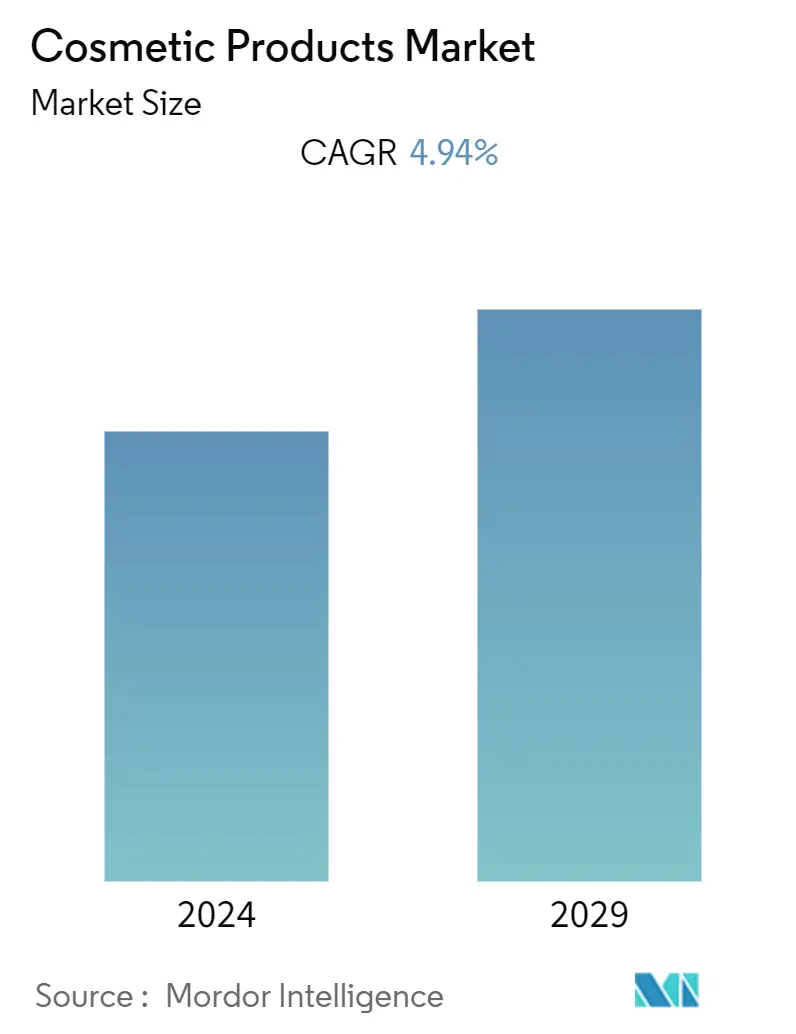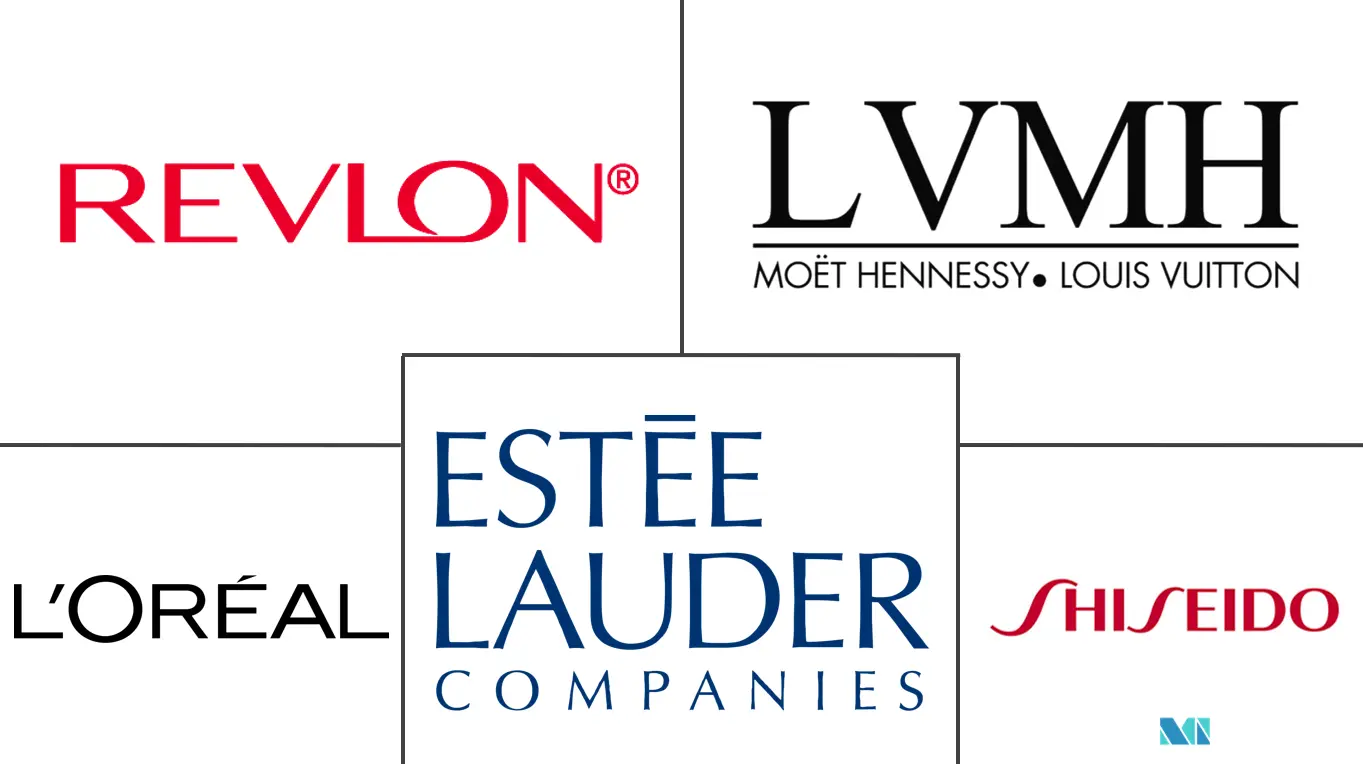Market Size of Cosmetic Products Industry

| Study Period | 2019 - 2029 |
| Base Year For Estimation | 2023 |
| CAGR (2024 - 2029) | 4.94 % |
| Fastest Growing Market | Asia Pacific |
| Largest Market | North America |
| Market Concentration | Low |
Major Players
*Disclaimer: Major Players sorted in no particular order |
Cosmetic Products Market Analysis
The Cosmetic Products Market is expected to register a CAGR of 4.94% during the forecast period.
- The increasing number of working women and rising consciousness regarding physical appearance among millennial women are the key factors driving the market growth. In addition, the rising awareness about the harmful effect of chemical compounds such as paraben and aluminium in the products is stimulating the growth of natural and organic facial cosmetic products in the market.
- Thereby, the manufacturers were focused on innovating facial cosmetics with natural ingredients. Additionally, Heritage brands are losing their popularity. They need to be updated as new storytelling brands emphasizing vegan, cruelty-free, organic, and natural concepts are trying to capture the market by offering a product that matches evolving consumer preferences.
- There is an increasing demand for long-lasting and waterproof makeup, sun protection makeup with SPF, and vitamin enhancement makeup. This, in turn, offers a lucrative opportunity to the key players in the category to innovate in the facial make-up market. For instance, in 2021, Coty Inc. expanded the Gucci beauty product line by launching Gucci Poudre De Beauté Mat Naturel face powder in Asia-Pacific and European markets.
Cosmetic Products Industry Segmentation
Any product intended to maintain, enhance, or modify the appearance of the skin, hair, and nails is referred to as a "cosmetic."
The market studied is segmented by product type, category, distribution channel, and geography. Based on product type, the market studied is segmented into facial make-up products, eye make-up products, lip make-up products, and nail make-up products. Based on category, the market is segmented into mass and premium. Also, based on distribution channels, the market studied is segmented into specialty stores, supermarkets/hypermarkets, pharmacy/drug stores, online retail stores, and other distribution channels. The study also covers the global analysis of the major regions, such as North America, Europe, Asia-Pacific, South America, the Middle East, and Africa.
For each segment, the market sizing and forecasts have been done on the basis of value (in USD million).
| Product Type | |
| Facial Make-up Products | |
| Eye Make-up Products | |
| Lip Make-up Products | |
| Nail Make-up Products |
| Category | |
| Mass | |
| Premium |
| Distribution Channel | |
| Hypermarkets/Supermarkets | |
| Specialty Stores | |
| Online Retail Stores | |
| Pharmacies and Drug Stores | |
| Other Distribution Channels |
| Geography | |||||||||
| |||||||||
| |||||||||
| |||||||||
| |||||||||
|
Cosmetic Products Market Size Summary
The cosmetic products market is experiencing significant growth, driven by factors such as the increasing number of working women and heightened awareness of physical appearance, particularly among millennial women. This trend is further bolstered by a growing preference for natural and organic products, as consumers become more conscious of the harmful effects of chemical compounds like parabens and aluminum. Manufacturers are responding by innovating facial cosmetics with natural ingredients, while heritage brands are losing ground to newer brands that emphasize vegan, cruelty-free, and organic concepts. The demand for long-lasting, waterproof, and sun-protective makeup is creating lucrative opportunities for key players to innovate in the facial makeup segment.
The market for organic, cruelty-free, vegetarian, and vegan cosmetics is gaining traction, especially in developed countries and emerging markets such as India, China, and Brazil. Consumers are increasingly opting for products made from plant extracts and natural oils, which are perceived as safer alternatives to synthetic cosmetics. The color cosmetics industry, particularly in India and China, is thriving, with local companies offering herbal and ayurvedic products. Premium global brands are also expanding their presence in these markets, catering to the growing demand for advanced and specialized cosmetic products. The competitive landscape is marked by the presence of both regional and global players, who are investing in R&D, marketing, and expanding distribution channels to maintain their market position.
Cosmetic Products Market Size - Table of Contents
-
1. MARKET DYNAMICS
-
1.1 Market Drivers
-
1.2 Market Restraints
-
1.3 Porter's Five Forces Analysis
-
1.3.1 Threat of New Entrants
-
1.3.2 Bargaining Power of Buyers/Consumers
-
1.3.3 Bargaining Power of Suppliers
-
1.3.4 Threat of Substitute Products
-
1.3.5 Intensity of Competitive Rivalry
-
-
-
2. MARKET SEGMENTATION
-
2.1 Product Type
-
2.1.1 Facial Make-up Products
-
2.1.2 Eye Make-up Products
-
2.1.3 Lip Make-up Products
-
2.1.4 Nail Make-up Products
-
-
2.2 Category
-
2.2.1 Mass
-
2.2.2 Premium
-
-
2.3 Distribution Channel
-
2.3.1 Hypermarkets/Supermarkets
-
2.3.2 Specialty Stores
-
2.3.3 Online Retail Stores
-
2.3.4 Pharmacies and Drug Stores
-
2.3.5 Other Distribution Channels
-
-
2.4 Geography
-
2.4.1 North America
-
2.4.1.1 United States
-
2.4.1.2 Canada
-
2.4.1.3 Mexico
-
2.4.1.4 Rest of North America
-
-
2.4.2 Europe
-
2.4.2.1 United Kingdom
-
2.4.2.2 Germany
-
2.4.2.3 Spain
-
2.4.2.4 France
-
2.4.2.5 Italy
-
2.4.2.6 Russia
-
2.4.2.7 Rest of Europe
-
-
2.4.3 Asia-Pacific
-
2.4.3.1 China
-
2.4.3.2 Japan
-
2.4.3.3 India
-
2.4.3.4 Australia
-
2.4.3.5 Rest of Asia-Pacific
-
-
2.4.4 South America
-
2.4.4.1 Brazil
-
2.4.4.2 Argentina
-
2.4.4.3 Rest of South America
-
-
2.4.5 Middle East & Africa
-
2.4.5.1 United Arab Emirates
-
2.4.5.2 South Africa
-
2.4.5.3 Rest of Middle East & Africa
-
-
-
Cosmetic Products Market Size FAQs
What is the current Cosmetic Products Market size?
The Cosmetic Products Market is projected to register a CAGR of 4.94% during the forecast period (2024-2029)
Who are the key players in Cosmetic Products Market?
The Estée Lauder Companies Inc., L'Oréal S.A., Shiseido Company, Limited, LVMH Moët Hennessy Louis Vuitton and Revlon, Inc. are the major companies operating in the Cosmetic Products Market.

